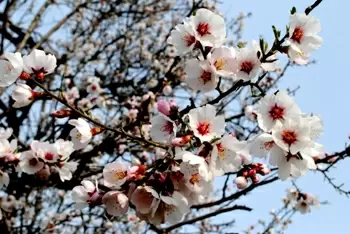Tourism industry is hopeful of doing good business as Kashmir turns warm

29-March-2013
Vol 4 | Issue 13
Bright yellow mustard flowers, purple-white almond and cherry blossoms and emerald green meadows. It's a riot of colour as Kashmir Valley welcomes spring after months of an icy winter.
It's the season of revival, the time for murmuring streams and chirping birds, for people to shake off the layers of woolens and embrace life with song and dance.
 |
|
Almond blossoms in Srinagar's 'Badamwari'. Almonds are among the first fruit trees to blossom (Photos:Raashid Bhat/IANS)
|
After three months of bone-chilling cold, when locals swathe themselves with woollens and stay mostly indoors, the arrival of spring is celebrated with music, song and festivity.
"Till the late 1970s, people of Srinagar city celebrated the season of flowers in a big way. Men, women and children would throng the Badamwari (Almond Garden) in the city where folk singers would keep performing for many days.
"The visit to the Badamwari was a much awaited event since this was often the first outing for the locals after three months of bitter winter," recalled Muhammad Afzal, 73, a resident of old city Srinagar.
The years of militancy took their toll. For many years, Badamwari remained neglected and deserted because of the volatile situation in this summer capital of Jammu and Kashmir.
But as spring arrives, so does the old glory of Badamwari.
"With the help of the local Jammu and Kashmir Bank, we have brought back Badamwari to its old glory," said a senior state government official here.
And so, once again, tourists and locals can be seen thronging the place, pausing to capture the moment on cameras big and small to carry a bit of the floral magic back for family albums. It's a common, happy sight to see couples posing for photographs alongside flower-laden almond trees.
The birds seem to have woken up too.
As yellow mustard flowers dot the countryside, orioles and starlings start arriving to feed and nest during the summer months.
The birdsong and murmuring streams, fed by melting snow in the mountains, beckon local people and outsiders too.
"Kashmir is really at its best during the spring months. I have come here during almost all the seasons, but nothing to beat the season of flowers," said Suresh Kumar, 42, a tourist from Delhi who visited Badamwari.
After remaining frozen in parts for many months, the Dal Lake in summer capital Srinagar is also abuzz with life. Fishermen and picnickers dot the expansive Lake.
But this is also the time to say some goodbyes.
The last flocks of migratory birds are seen, feeding away before the long flight back.
Migratory birds have to build enough fat reserves to sustain the exhausting journey back to their summer homes in Russian Siberia, Japan, China, the Philippines or Eastern Europe, flying thousands of miles each year.
"This year the Valley hosted more than 700,000 migratory birds, including graylag geese, mallards, pochards, shovellers, wigeons, teals and gadwalls. It is time to bid adieu to these avian visitors as they start to leave for their summer homes," said an official of the state wildlife protection department.
As the migratory birds leave, the Valley waits to receive tourists; the tourism industry in the state is linked to the livelihoods of several thousands.
In 2011, over one million tourists visited the Valley; besides, 500,000 devotees went for the Amarnath pilgrimage. In 2012, this reached 1.3 million tourists and 750,000 Amarnath pilgrims.
What will this year be like?
The recent attacks on troopers in the Valley cast their shadow, but industry insiders say they are hopeful despite cancellations.
"No doubt the tourism industry has been seriously jolted because of the disturbances during the last over one month, but we are expecting things to improve soon," said a travel agent here, expressing the hope that only just looking around would convince tourists that nature meant Kashmir for beauty and peace. - IANS














